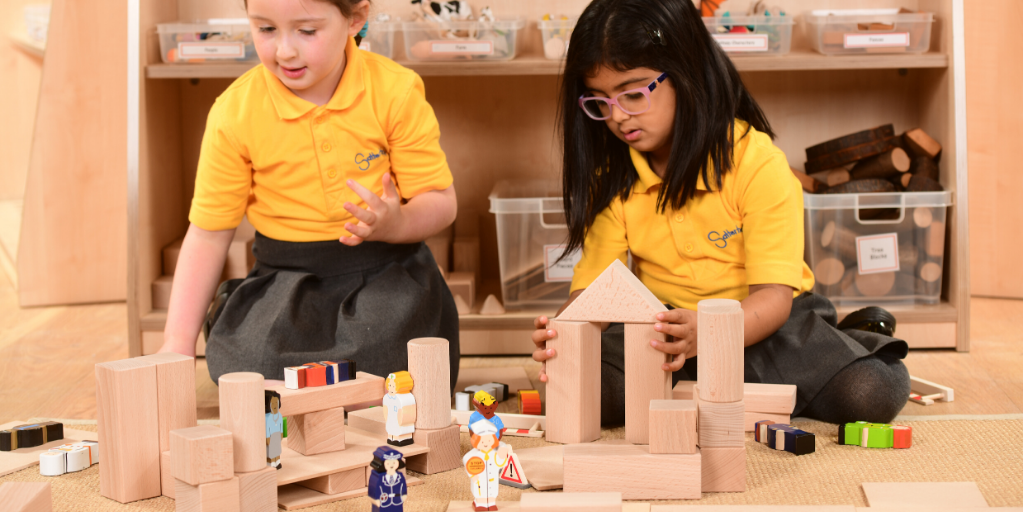Some areas of provision and collections of resources are most effective when used in relation to others and can effectively support the teaching and learning of the prime areas particularly communication and language. One good example of this is the small world and block area.
This article is also available as a podcast:
Meaningful Opportunities for Independent Exploration
Especially at the start of the school year, you have probably spent time reviewing your provision, thinking about the starting points of your children and how your provision will support the fundamental foundations of learning and the prime areas such as communication and language.
Decisions you make about how you organise and arrange your classroom will have a big impact on the quality of the learning that occurs there. Well organised, well planned provision areas provide meaningful opportunities for independent exploration, effective interactions and focussed teaching. At this time of year, a focus on the prime areas is crucial, so ensuring that your provision supports the learning and development within the prime areas is key.
Some areas of provision and collections of resources are most effective when used in relation to others and can effectively support the teaching and learning of the prime areas particularly communication and language. One good example of this is the small world and block area.
What would a small world and block area look like and how might it be organised?
To get the best out of both areas, the small world and block area should be situated together. In this way, children will be able to use the blocks to create their own story settings and scenes for the small world characters they choose. This will be far more effective than providing the children with a prepared or manufactured small world setting, such as a dolls’ house or toy castle as it will engage them in the process of building, encourage them to share their ideas and talk about what they know and enable children to modify their ideas as they play.
For small world and block play to be effective, you’ll need a clearly defined area where children can access the resources as independently as possible. Create the space away from any high traffic areas in your classroom and provide enough room if possible, for large, elaborate buildings and story settings to take shape. A carpet or rug will deaden the noise and make the space more comfortable for the children to kneel.
What about small world and block resources?
Carefully selected resources will enable effective learning and development, particularly in the development of language and vocabulary, storytelling and understanding the world.
With a focus on Small World, you ideally need to think about the broad range and variety you offer. Think about children’s first experiences and characters they may come across. Do you offer a range of people including differing occupations, abilities, ages and ethnicities? Do you have a variety of pets, including a range of breeds? Then think about animals children may come across such as farm animals. Again, here it’s an ideal opportunity to reflect upon the range and variety you offer. For example, opportunities to teach vocabulary such as cow, calf, or herd. As children progress into Reception you may think about broadening these characters to Safari animals, and further into KS1 where the children’s storytelling will move into more fantasy story stories.
To support Small World Play you will need to consider your block play area. You’ll need a good selection of wooden blocks which offer lots of possibilities for exploration and discussion. The blocks should be of different sizes and should also include a wide range of mathematically regular shapes: cubes, cuboids, cylinders, cones – as well as more unusual wooden shaped blocks such as rainbow blocks, reels or natural wooden pieces. In addition to this, you might want to add different shapes and sizes of wooden boards so that the children can link towers together and also create floors within buildings. As you’re planning this space, you might also want to consider other materials to spark the children’s curiosity, imagination and promote language development. Mirrored or clear perspex blocks, wooden arches and doorways can be a great imaginative starting point for young children’s ideas. You might also want to consider reclaimed materials such as cardboard cylinders, buttons and plastic reels; the more open-ended the better!
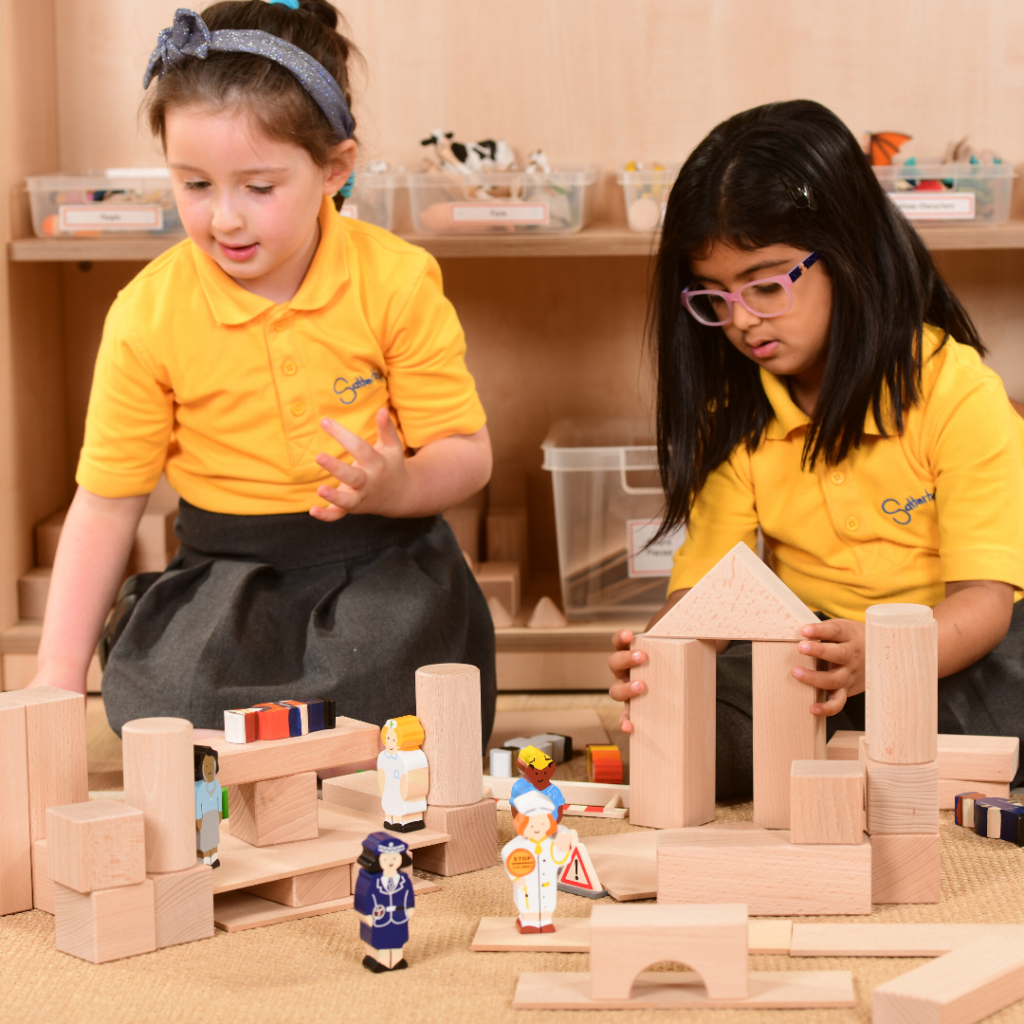
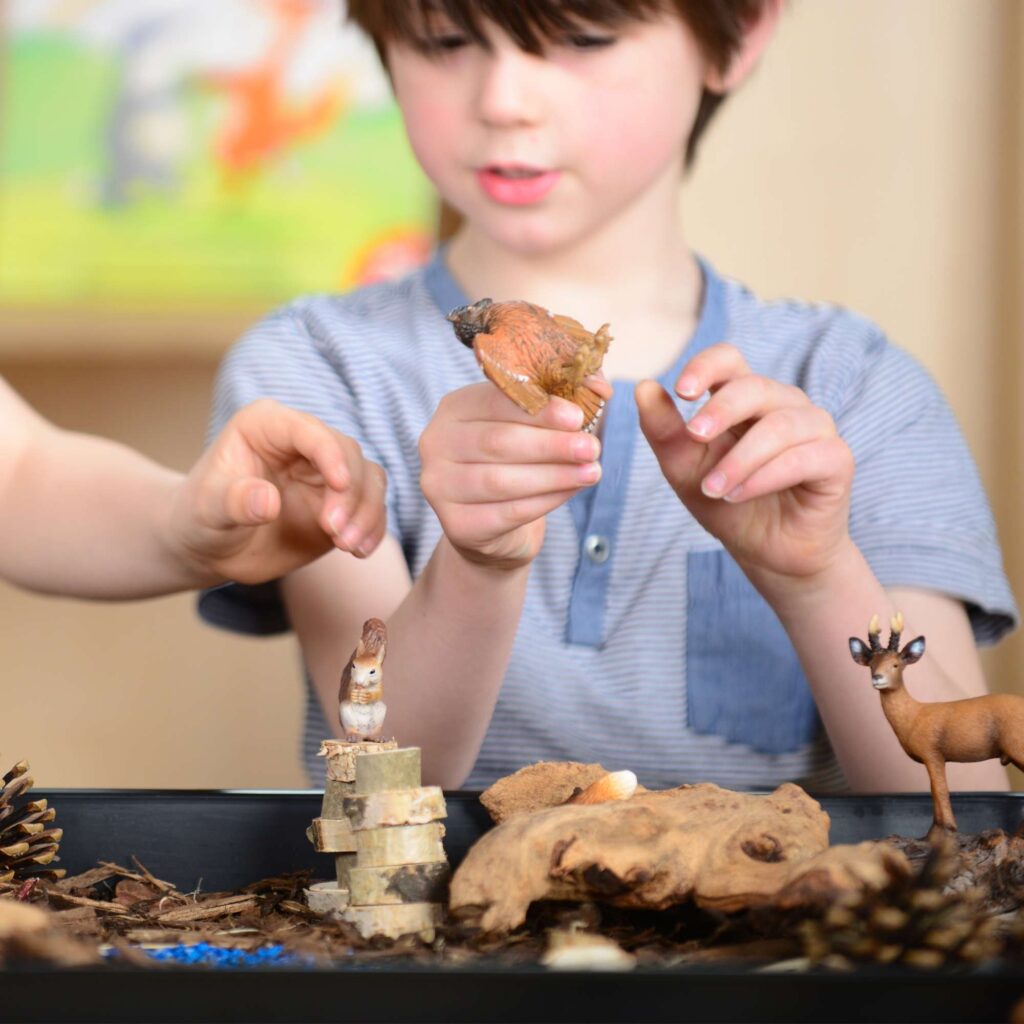
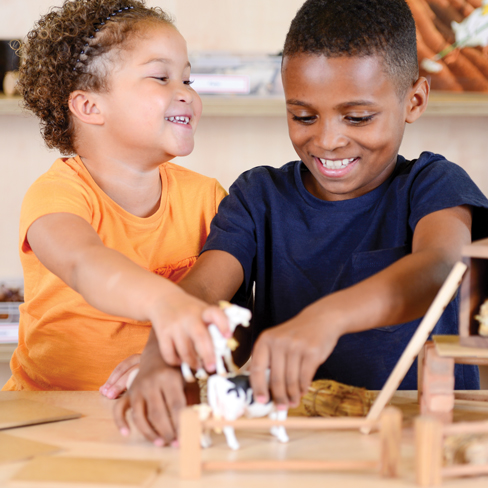
Now we’ll need to consider how these blocks are stored and organised in order to promote independence and to maximise the number of learning opportunities provided- an effective way to support the development of personal, social and emotional learning. Ideally, blocks should be stored directly onto an open shelf so that the children can readily access them. Shadow backing on each shelf promotes easy access and, done well, can lead to discussions around shapes and their properties. For this you’ll need a roll of sticky backed plastic; this can be cut out and stuck directly onto a shelf to provide a place for each shape of block. Store some shapes together so that the children are encouraged to recognise both the parts and the whole. For example, two semi -circular, arched shapes placed together will create a circular shape.
For a KS1 Block Area, labelling could include a further degree of challenge. In this way, you might include cylinders set out as an array (labelled as 3 + 3 +3 etc): measurements can be included effectively too: cylinders could be labelled as 15cm cylinders or 10 cm cylinders, for example. With effective adult support, this level of detail promotes discussion and the use of correct terminology.
As the children’s ideas develop, and as they become particularly interested in themes or concepts, you’ll want to enhance your provision with other materials to challenge their thinking further. Collections of big rolls of paper and pens, when modelled by an adult, are a great way of engaging the children in story mapping and writing as part of small world and block play. At other times, mirrors or different light sources can prompt further explorations of reflection, light and shadow.
What about adult interactions with small world and blocks?
If we’ve thought through all the learning opportunities in such a detailed way, then it’s also important to consider the adult role in this space too. Well planned resources and experiences provide a range of learning opportunities but these need to be maximised by the adults in the setting.
Adults should use the correct names of shapes when talking about the block area and engage with the children’s ideas within this space.
Adults should also think carefully about supporting the language development and teaching of vocabulary when engaged in small world play. Consider using the terms that categorise groups of animals such as herd of cows or pride of lions. Think about the vocabulary used to discuss animals and their young, for example, cat, kitten, horse, foul.
Consider where there are times in the day for the children to talk about what they plan to do or to review what they have already done within this space. Conversations like these are an opportunity to celebrate and value their learning and can take children’s learning to a new level, reinforcing new vocabulary and challenging their ideas and concepts.
Key questions to ask yourself:
- How often does your team engage with children in this area throughout the day?
- Do adults use the space, when appropriate, for directed activities including Prime and Specific areas of learning.
- Do they facilitate and support the children’s learning in the small world and block area on a regular basis?
- Are children’s ideas in the small world and block area seen as stories and celebrated as such?
- Do adults have a clear understanding of what language and vocabulary they can teach within the small world and block area?
Next Steps:
Do you want to enhance creative play, exploration, and language development? Take a look at our curated complete Small Block Areas and Small World Areas, or explore our wide range of Wooden Blocks and Rainbow Blocks for yourself!
Find out more

Want practical ideas to develop your classroom practice? Discover the Early Excellence Inspiration Hub app – packed with expert guidance, inspiring videos, and resources for early years practitioners.
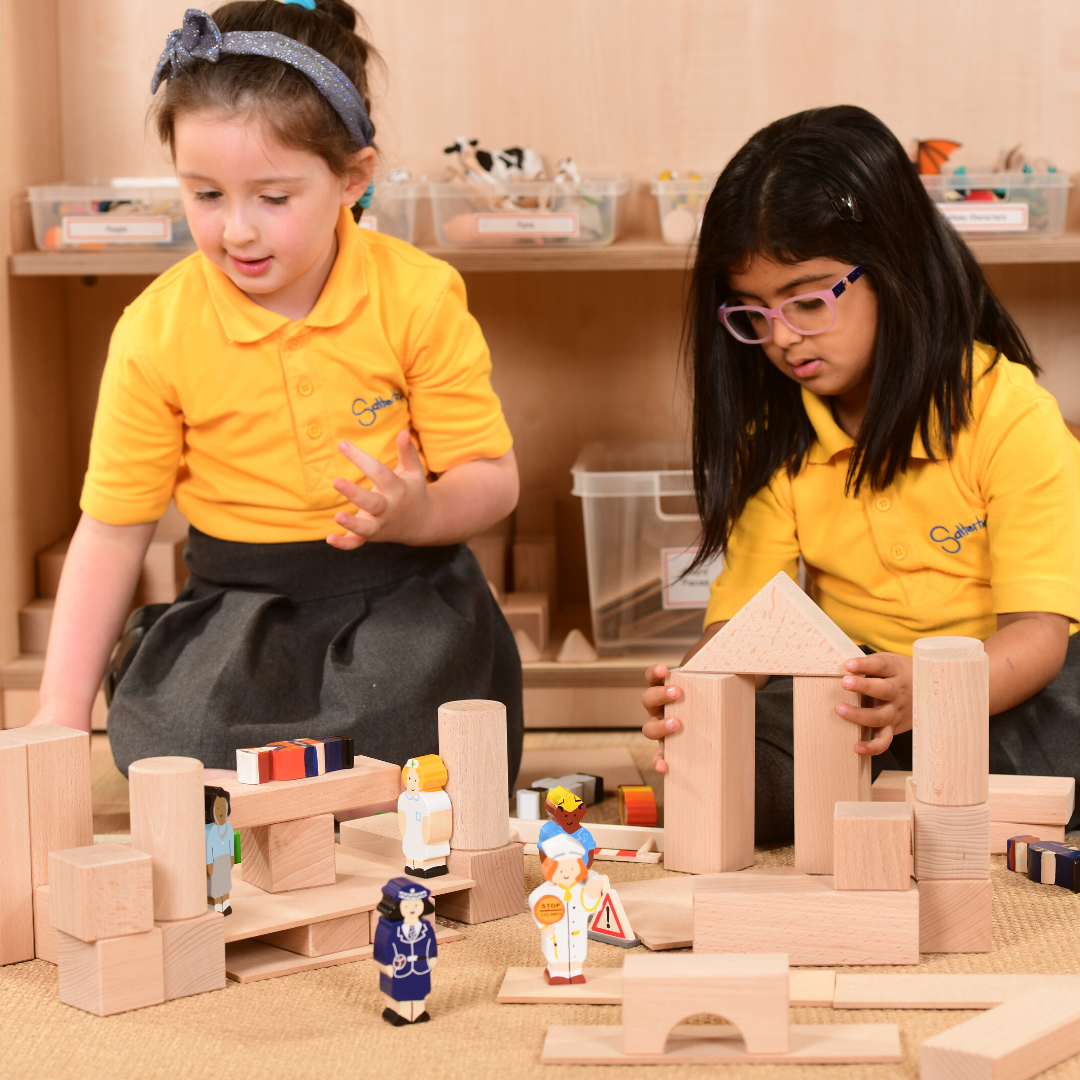
Enhance creative play, exploration, and language development with our curated selection of Small World & Block Resources, including Wooden Blocks and Rainbow Blocks.
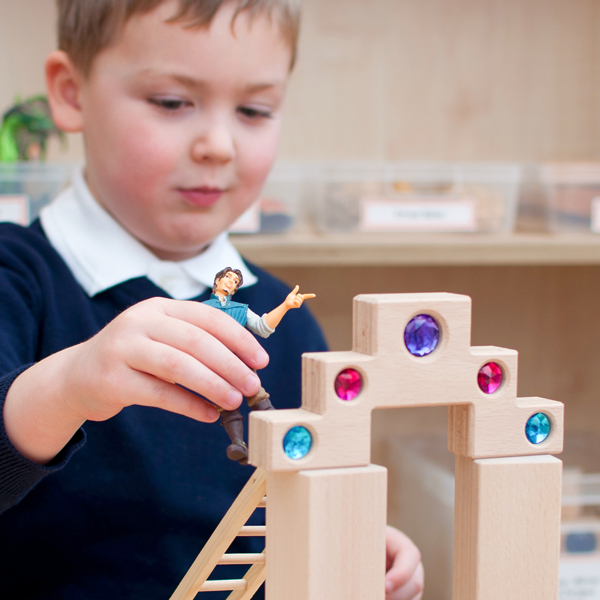
Explore our Inside Out pack of support materials for small world with practical advice, training videos and inspiration to help you make the most of your provision.

